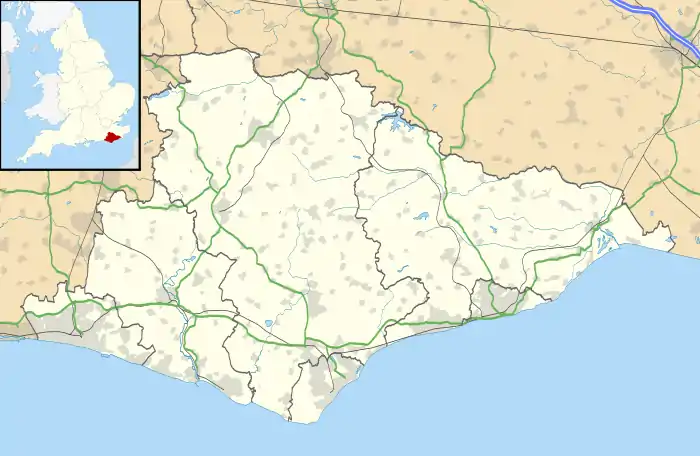Playden
Playden is a village and civil parish in the Rother district of East Sussex, England. The village is located one mile (1.6 km) north-west of Rye.
| Playden | |
|---|---|
 Playden Location within East Sussex | |
| Area | 16.6 km2 (6.4 sq mi) -inc East Guldeford[1] |
| Population | 340 (Parish-2011)[2] |
| • Density | 51/sq mi (20/km2) |
| OS grid reference | TQ925226 |
| • London | 52 miles (84 km) NW |
| Civil parish |
|
| District | |
| Shire county | |
| Region | |
| Country | England |
| Sovereign state | United Kingdom |
| Post town | RYE |
| Postcode district | TN31 |
| Dialling code | 01797 |
| Police | Sussex |
| Fire | East Sussex |
| Ambulance | South East Coast |
| UK Parliament | |

Within the parish there is a Site of Special Scientific Interest (SSSI), Houghton Green Cliff. This is an exposed cliff face displaying sandstones of geological interest.[3]
In addition, part of the Dungeness, Romney Marsh & Rye SSSI lies within Playden parish
History
Playden is mentioned in the Domesday Book as Pleidena; it is a largely rural parish, having no village centre, and the hamlet of Houghton Green is included in the parish. Playden's main occupation was fishing: the fish were salted in a one-time settlement known as Saltcote, after the fact that it had a fish salting industry based there. Saltcote Street is now all that remains of that industry.[4]
The Norman church is dedicated to St Michael.[5]
The field in front of the Church formerly known as Beacon Oak Field was the site of a 15th century beacon at Sawcut (sic), sighting from Tenterden and Alomsbridge (about Newington Bridge, Kent, name has disappeared). The beacon was in the form of a tar filled barrel in an oak tree that was burnt down around 1930 but the stump remains.
Leasam House is a Georgian mansion, built on the site of the medieval manor house. The old manor house was demolished by the Town Clerk of Rye, Jeremiah Curteis, in 1790 and the current building completed c1806. [6] It formerly served as a boarding house for boys at Rye Grammar School, closing in 1992. [7]
People
The artist and scientific illustrator Brian Hargreaves (1935-2011) lived in Playden up until the time of his death.[8]
Architecture
Playden and the greater Rye area is well known for its Oast Houses. Originally used for storing and drying grain for beer. An Oast House is unique conical building with domed roof. Adorning the domed roof is a distinctive white capping that is called a 'cowl' . The cowl functions to keep the weather out and encourage air flow. The direction of the cowl moves with the wind and the creaking sound it makes is a distinctive feature of the Oast House. Many Oast Houses dot the country side throughout Playden. Many have been converted into private residences, however the Playden Oasts Hotel offers accommodation and meals to the public.
References
- "East Sussex in Figures". East Sussex County Council. Retrieved 26 April 2008.
- "Civil Parish population 2011". Retrieved 7 October 2015.
- "SSSI Citation — Houghton Green Cliff" (PDF). Natural England. Retrieved 5 July 2008. Cite journal requires
|journal=(help) - Notes on the village Archived 2008-03-27 at the Wayback Machine
- St Michael's church Archived 2007-03-10 at the Wayback Machine
- "Leasam House School". British Listed Buildings. Retrieved 23 July 2020.
- "50 year anniversary". Ryes Own Magazine. Retrieved 23 July 2020.
- Rhone, Christine. "Brian Hargreaves". Rye Castle Museum. Retrieved 8 June 2019.
6 A New History of Rye, Leopold Aaron Vidler, 1934
7 A Perambulation of Kent, William Lambarde, 1596
8 The History, Antiquities and Topography of the County of Sussex, Thomas Walker Horsfield, 1825
